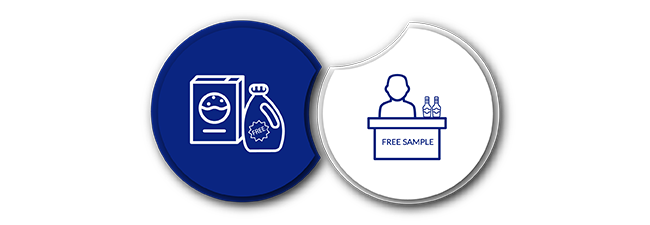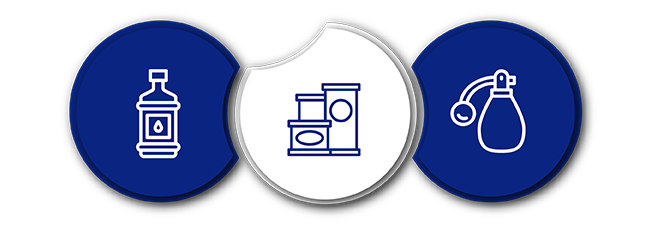One thing is sure: your customers love getting free products. Of course, it helps if the items turn out to be of value. Such as a product sample that makes their lives easier. Or, a tasty snack for them to eat while they shop. But the point remains; when done right, product sampling can work. It’s also why it’s an opportunity worth embracing wherever possible.
You only need to consider any FMCG stores where it is a well-known feature. Costco is a primary example here.
That said, product sampling isn’t necessarily for every brand. At least not in the traditional sense of product samples where you give away merchandise in-store. However, that doesn’t mean you should disregard it completely.

What is product sampling? [and does it work]
At its core, product sampling is straightforward so we’re not going to spend too much time unpacking the definition.
In simple terms, product sampling is the act of handing out free samples of a product to shoppers who visit a store so that they can test it out. What is more important to consider is why it works (and why you should use it).
There are many benefits to including a product sampling element in your store.
For one, the fact that customers can test out a product for free means it’s completely risk-free for them. If they don’t like the product, there is no buyers remorse. If they do like it, they can add it to their basket, and you can make the sale. Additionally, they’ll leave having had a better experience because you’ve offered them something of value.
Another benefit is that you’re giving shoppers the opportunity to directly interact with a product.
The fact that they can get up close and personal with your product increases the possibility of buying your product. That’s because you’re connecting with your customers and creating a personality around your brand.
A Product Sampling Study conducted by Arbitron and Edison Media Research confirms that. The study found that 35% of customers who sampled a product bought it the same day while 26% bought it immediately.
And it doesn’t matter if it’s for a new product or an item that you’ve always stocked. In the case of an older product, by allowing your customers to familiarise themselves with it you could surprise them and persuade them to buy it going forward.
A third benefit is that by making use of sampling, you have every opportunity to create a market and generate demand for a product that shoppers have not seen or experienced.
As the above survey pointed out, 24% of respondents claimed that they had purchased a sampled product over the item they intended to buy when they first entered the store.

Which primary product sampling methods are available to you?
When it comes to offering a product sample, there are generally two methods that you can consider using in your store.
On the one hand, there is the indirect sampling route. Its opposite is direct sampling. Below, we dig into each in more detail so you can decide which one works best for you.
1. Indirect Sampling
In the context of retail, indirect sampling refers to any approach where there is no physical interaction between yourself and the customers.
In this instance, you could offer free samples of a product to shoppers when they buy another product from your range. It could be in the form of a product bundle on the shelf or you could ensure that store staff hand the free sample over at checkout. For example, if you sell washing powder, you could attach a sachet of liquid detergent for shoppers to test out.
As for why it’s worth applying this method in-store, the primary advantage is that its effortless and adds value to the original purchase. You’re offering shoppers more by pairing up two products that you know go well together. For example, offering a complimentary sauce whenever a shopper buys a particular food item allows them to try the sauce when they cook it at home.
Also, since shoppers take the item home, you’re able to engage with a broader group of people. For example, if your shopper has a family and you’ve offered a free sauce, everyone could try it.
Of course, there is a negative to this form of sampling. It’s a disadvantage that can cause you not to attempt this method. It’s that you have no way of knowing if a customer used your product.
There is no instant feedback. More than that, you have no idea if they used it correctly and whether the outcomes were as you had expected. That’s even if you provide instructions on how to best use the products in tandem.
To counteract that, you could include contact information and request they provide you with feedback. But even then, regardless of if they had a good or bad experience, you are not guaranteed to hear back from them.
2. Direct Sampling
While indirect product sampling is essentially remote selling - you’re letting your product do all the work; direct sampling is the exact opposite.
What’s more, you can break this method down further into two categories: dry and wet sampling. While both have the same goal - to allow your customers to test the product, you’d execute each differently.
Let’s look at Dry sampling first. Similar to your indirect sampling, this is an approach in which you’d offer shoppers products for them to test at home. Of course, you would use this with a promotional stand and ensure there is a salesperson to explain to you how to use the product. You’re thus not cutting yourself out completely - there is some form of personal interaction.
For example, you could demonstrate a product in-store, explaining as much as you can about it, and then offer samples for shoppers to take home.
If that is not to your liking, you can consider wet sampling. Known as the most popular direct sampling method, it’s where you offer products to consumers in-store. It’s thus more appropriate for you if you have a tasting sample.
While the two are slightly different, there is an opportunity to combine the two. For example, let shoppers taste a product and then give them a small sample to try at home.
As for the benefits, there are also a few. For dry sampling, the main advantage is that you can keep costs down while you engage with an already interested shopper. By offering samples in store, it’s also easier to increase the awareness of your brand than if you were to follow an indirect sampling tactic.
Meanwhile, for wet sampling, you could aim at your target market. For example, if you sell coffee, you could set up a promotional stand in the coffee aisle of a supermarket. If you’re a high-end store, you could launch a new product in-store and then invite select customers who you know are both regular spenders and are interested in the specific product.
That said, there are disadvantages to following a direct sampling method. The first is that it is an expensive way of promoting your product. There are the additional costs of the promotional stand and the advertising banners that you’d need to consider. If you turn to a promotions company, you would also need to factor in labour costs.
There is also the point that if you attempt dry sampling, shoppers might throw the sample away as soon as they get home or lose it. And similar to indirect sampling, there is no direct feedback.

Who should invest in product sampling?
There is no doubt that the vast majority of brands can benefit from product sampling. That’s because offering a product for free in exchange for additional future sales makes for an enticing prospect.
So who would invest in this? More importantly, what approach should you take?
If you’re an established lifestyle brand in a niche market, you could consider doing the wet sampling route. That’s because you know your clients are a small group who have bought your brand in the past. You can target them specifically.
However, if your target market is broader, dry sampling would be a better choice. Take DotActiv, for example. While our software is targeted at retailers and suppliers, it’s not limited to the type of merchandise you offer. As such, we’ve done (and continue to do) dry sampling by offering DotActiv Free. It’s a free version of our software for you to test.
As for who shouldn’t invest in product sampling, it depends largely on your product as opposed to your brand.
For example, if you’re a plant nursery and garden store, is there a market to test a new hosepipe for your garden? Probably not. However, if your sell plants, you could offer free samples of seeds or bulbs. Or even bundle them together with another purchase if your customer has spent a certain amount in your store.
Besides that, the best way to determine if your product is a candidate for product sampling or not is to ask yourself if it engages any senses. It doesn’t have to be all senses; it can appeal to at least one.
For example, if you’re a bakery, you could offer baking powder or cake mix as a sample as it engages the sense of smell. If you sell coffee, you could go the dry or wet sampling route as it engages both taste and smell.
In fact, food and drink are the two obvious contenders. You could also look at perfume and other products that shoppers could test out in-store or at home as well as products within your skin and face care categories.
Conclusion
DotActiv Lite, Pro, and Enterprise are all different versions of our category management software that allows you to drive category performance. You can visit our online store here or book your free custom exploratory consultation here.


